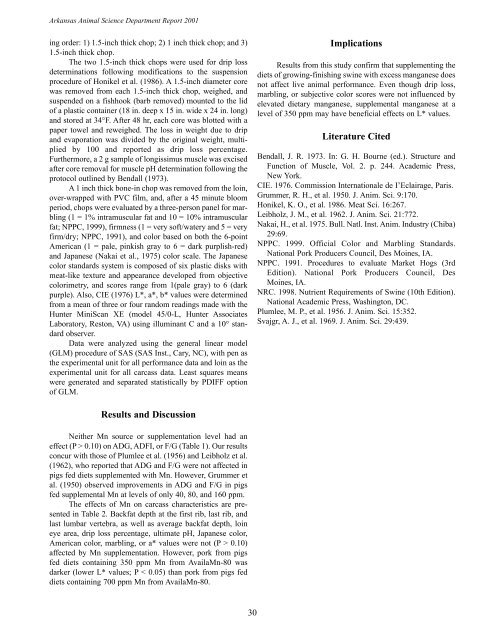Arkansas - Agricultural Communication Services - University of ...
Arkansas - Agricultural Communication Services - University of ...
Arkansas - Agricultural Communication Services - University of ...
You also want an ePaper? Increase the reach of your titles
YUMPU automatically turns print PDFs into web optimized ePapers that Google loves.
<strong>Arkansas</strong> Animal Science Department Report 2001<br />
ing order: 1) 1.5-inch thick chop; 2) 1 inch thick chop; and 3)<br />
1.5-inch thick chop.<br />
The two 1.5-inch thick chops were used for drip loss<br />
determinations following modifications to the suspension<br />
procedure <strong>of</strong> Honikel et al. (1986). A 1.5-inch diameter core<br />
was removed from each 1.5-inch thick chop, weighed, and<br />
suspended on a fishhook (barb removed) mounted to the lid<br />
<strong>of</strong> a plastic container (18 in. deep x 15 in. wide x 24 in. long)<br />
and stored at 34°F. After 48 hr, each core was blotted with a<br />
paper towel and reweighed. The loss in weight due to drip<br />
and evaporation was divided by the original weight, multiplied<br />
by 100 and reported as drip loss percentage.<br />
Furthermore, a 2 g sample <strong>of</strong> longissimus muscle was excised<br />
after core removal for muscle pH determination following the<br />
protocol outlined by Bendall (1973).<br />
A1 inch thick bone-in chop was removed from the loin,<br />
over-wrapped with PVC film, and, after a 45 minute bloom<br />
period, chops were evaluated by a three-person panel for marbling<br />
(1 = 1% intramuscular fat and 10 = 10% intramuscular<br />
fat; NPPC, 1999), firmness (1 = very s<strong>of</strong>t/watery and 5 = very<br />
firm/dry; NPPC, 1991), and color based on both the 6-point<br />
American (1 = pale, pinkish gray to 6 = dark purplish-red)<br />
and Japanese (Nakai et al., 1975) color scale. The Japanese<br />
color standards system is composed <strong>of</strong> six plastic disks with<br />
meat-like texture and appearance developed from objective<br />
colorimetry, and scores range from 1(pale gray) to 6 (dark<br />
purple). Also, CIE (1976) L*, a*, b* values were determined<br />
from a mean <strong>of</strong> three or four random readings made with the<br />
Hunter MiniScan XE (model 45/0-L, Hunter Associates<br />
Laboratory, Reston, VA) using illuminant C and a 10° standard<br />
observer.<br />
Data were analyzed using the general linear model<br />
(GLM) procedure <strong>of</strong> SAS (SAS Inst., Cary, NC), with pen as<br />
the experimental unit for all performance data and loin as the<br />
experimental unit for all carcass data. Least squares means<br />
were generated and separated statistically by PDIFF option<br />
<strong>of</strong> GLM.<br />
Implications<br />
Results from this study confirm that supplementing the<br />
diets <strong>of</strong> growing-finishing swine with excess manganese does<br />
not affect live animal performance. Even though drip loss,<br />
marbling, or subjective color scores were not influenced by<br />
elevated dietary manganese, supplemental manganese at a<br />
level <strong>of</strong> 350 ppm may have beneficial effects on L* values.<br />
Literature Cited<br />
Bendall, J. R. 1973. In: G. H. Bourne (ed.). Structure and<br />
Function <strong>of</strong> Muscle, Vol. 2. p. 244. Academic Press,<br />
New York.<br />
CIE. 1976. Commission Internationale de I’Eclairage, Paris.<br />
Grummer, R. H., et al. 1950. J. Anim. Sci. 9:170.<br />
Honikel, K. O., et al. 1986. Meat Sci. 16:267.<br />
Leibholz, J. M., et al. 1962. J. Anim. Sci. 21:772.<br />
Nakai, H., et al. 1975. Bull. Natl. Inst. Anim. Industry (Chiba)<br />
29:69.<br />
NPPC. 1999. Official Color and Marbling Standards.<br />
National Pork Producers Council, Des Moines, IA.<br />
NPPC. 1991. Procedures to evaluate Market Hogs (3rd<br />
Edition). National Pork Producers Council, Des<br />
Moines, IA.<br />
NRC. 1998. Nutrient Requirements <strong>of</strong> Swine (10th Edition).<br />
National Academic Press, Washington, DC.<br />
Plumlee, M. P., et al. 1956. J. Anim. Sci. 15:352.<br />
Svajgr, A. J., et al. 1969. J. Anim. Sci. 29:439.<br />
Results and Discussion<br />
Neither Mn source or supplementation level had an<br />
effect (P > 0.10) on ADG, ADFI, or F/G (Table 1). Our results<br />
concur with those <strong>of</strong> Plumlee et al. (1956) and Leibholz et al.<br />
(1962), who reported that ADG and F/G were not affected in<br />
pigs fed diets supplemented with Mn. However, Grummer et<br />
al. (1950) observed improvements in ADG and F/G in pigs<br />
fed supplemental Mn at levels <strong>of</strong> only 40, 80, and 160 ppm.<br />
The effects <strong>of</strong> Mn on carcass characteristics are presented<br />
in Table 2. Backfat depth at the first rib, last rib, and<br />
last lumbar vertebra, as well as average backfat depth, loin<br />
eye area, drip loss percentage, ultimate pH, Japanese color,<br />
American color, marbling, or a* values were not (P > 0.10)<br />
affected by Mn supplementation. However, pork from pigs<br />
fed diets containing 350 ppm Mn from AvailaMn-80 was<br />
darker (lower L* values; P < 0.05) than pork from pigs fed<br />
diets containing 700 ppm Mn from AvailaMn-80.<br />
30

















